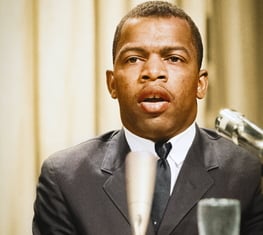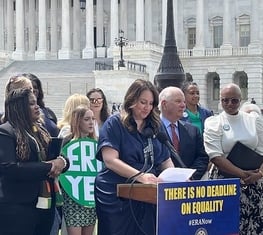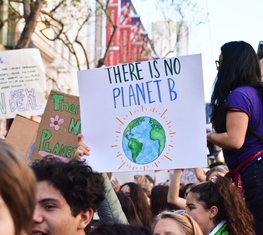Then and Now: How Two Pandemics Tested the Power of Women
The situation was critical. The outcome of elections across the US would determine the fate of the nation, yet voters faced an additional threat: a growing pandemic. In the months before the national election, mask mandates were passed, cities and states shut down, social gatherings banned, and almost 200,000 Americans had died due to a rampant virus. Political campaigns suspended in-person activities. Polling locations tried to determine how to open safely and protect voters. Millions of Americans started thinking through their voting plans so that they could make their voices heard despite the threat of viral contagion.
The year was 1918. And amid all of this, women were fighting for their right to political representation.
“Everything conspires against women’s suffrage. Now it is the influenza.”
—A local suffragist in the New Orleans Times-Picayune, October 1918.
Two years later, women won their right to vote, even with the pandemic still raging. Their cause was more powerful than the virus.
2020 saw us facing an eerily similar story, with the country facing both critical elections and a life-changing pandemic. Once again, women stepped forward to meet the challenges of their time, head-on, with grit and determination. As Women’s History Month ends, we honor those who came before us and those who stand with us now as we continue the fight for a more perfect democracy.
Then: Women Rise Despite Pandemic Risks
“These are sad times for the whole world, grown unexpectedly sadder by the sudden and sweeping epidemic of influenza. This new affliction is bringing sorrow into many suffrage homes and is presenting a serious new obstacle in our Referendum campaigns and in the Congressional and Senatorial campaigns. We must therefore be prepared for failure.”
— Carrie Chapman Catt, president of the National American Woman Suffrage Association, in a letter to supporters in 1918
When the 1918 flu pandemic overtook the nation, women had already gained momentum for a constitutional amendment securing their right to vote. Movement organizers were naturally concerned that the pandemic would derail their progress. The pandemic did indeed slow progress of the amendment even among suffragists. All their activities to support the movement were stymied by the health crisis, including public speeches, rallies, and donation collections.
“Just when we had plans developed for a renewed and revised campaign along comes the influenza and cuts off all possibility of public speaking and even meetings in open air. So many homes have been touched in each locality, if not with the actual disease, with the dreadful fear which seems to be worse, that we have not been able to work with the individual voter.”
—A local organizer
Despite the crisis, suffragists would not be deterred. They found ways to gather safely and have their voices heard. They made their priorities known to decisionmakers in the halls of government as well as voters across the country.
Inspiringly, they managed to keep the dream alive despite the health risks. They safely organized, assembled, and protested in cities and towns across the nation. Advocates held conventions and publicly challenged national and state policymakers to support the 19th amendment. In Chicago, the Illinois Equal Suffrage Association went ahead with its annual convention, excluding the public and positioning chairs four feet apart.
The movement would not be derailed, even if it cost women their jobs and had dramatic impacts on their families and homes. The campaign for the right to vote continued through the challenges and losses of the pandemic, World War I, and the often-violent opposition to women’s suffrage.
In August 1920, the hard work, perseverance, and sacrifices experienced during the pandemic paid off. The 19th amendment was ratified, and women won the right to vote. This was a significant victory, yet imperfect, as not ALL women were able to exercise their newly found right to vote because of racism and discrimination. Sadly, today we see far too many parallels to what we saw a century ago, with ongoing, rampant voter suppression and laws that far too disproportionately impact Black and brown voters.
Now: Women Lead Through a Pandemic
“I have always loved election day and the process of voting, and vote in every election. For years, I told my husband I wanted to volunteer ‘one day.’ Then, as COVID exploded across the country and it became clear that many regular volunteers might be afraid or unable to help, I knew my ‘one day’ had come. I volunteered to go anywhere in the county that might need additional help. I was particularly concerned about historically disenfranchised voters and less affluent areas of town.”
– First-time poll worker Kristin Rosengren, Richmond, Va.
In 2020, during one of the most significant and contentious elections in decades, women faced a new public health crisis: COVID-19. More than one hundred years after the 1918 pandemic, Americans stared down this new foe and, once again, women led and supported their communities through civil and political unrest, unprecedented voter suppression, and simultaneous economic and healthcare crises.
Women answered the call of democracy and worked the front lines of elections nationwide. Like their 1918 counterparts, they organized and identified procedures that would ensure the safety of voters while allowing as many as possible to participate.
League members and women across the country provided leadership and service as election processes were adapted or reimagined. As the number of poll worker volunteers dwindled due to the threat of COVID-19 exposure, women saw a need and they filled it. They kept the polls open for multiple days and supported mail-in ballots and absentee ballot collection, counting, processing, and auditing.
“Retirees usually volunteer to be poll workers, but with COVID-19, many were hesitant to put themselves at risk. I wanted to give older volunteers the option of putting their health first. I was worried about catching COVID-19, but felt somewhat young people, like me, were less at risk.”
– First-time poll worker Linda Sabelhaus, Washington, D.C.
Women also fought voter suppression policies and tactics by organizing and educating to build political power – and when that wasn’t effective, they fought legal battles and built campaigns to protect the rights of voters in all communities.
While contentious, the 2020 election cycle—including primaries and races up and down the ballot— happened with the largest voter participation in a general election in U.S. history. Over 159 million people voted in the U.S. general election due to the service and sacrifice of women leading, managing, and supporting voters.
Future: Women’s Impact on Democracy During a Pandemic
The 1918 Election happened – despite the pandemic – on November 4, 1918, as scheduled. The 2020 Election happened – despite another pandemic – on November 3, 2020, as scheduled.
This Women’s History Month, we celebrate how women power the vote, and our democracy, every day. We celebrate the determination of the women who raise their hands every time the world requires their sacrifice, creativity, and ability to get things done. As history has demonstrated, even during a global health crisis, women play a critical role in democracy and will not only rise, but lead.
The Latest from the League
The journey to enshrine equal rights among the sexes in the US Constitution has been a long one. But this year the ERA is closer than ever to taking its rightful place in the supreme law of our nation.
Board president, Dr. Deborah Turner reflects on the contributions to voting rights advancement from Black women.
A blog thanking election officials, workers, and volunteers.
Sign Up For Email
Keep up with the League. Receive emails to your inbox!
Donate to support our work
to empower voters and defend democracy.





